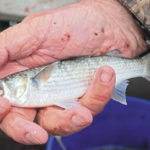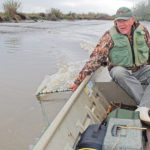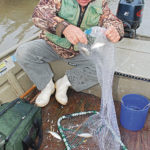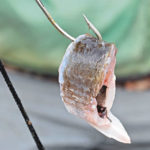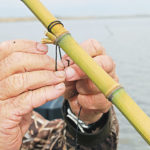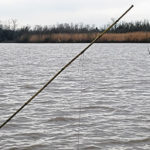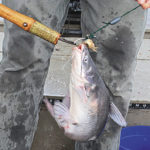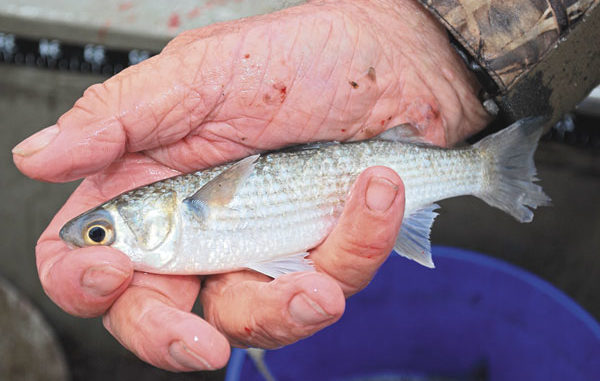
Set a row of catfish baits just off the Vermilion River, and you’ll catch enough to feed your neighborhood.
It was late February. The day was a beautiful blue respite from the drizzly overcast weather of the week before. The 70-year-old man across the table from me had the creased, tanned skin of an outdoorsman. He turned his head to gaze out the restaurant’s huge picture window at Toledo Bend Reservoir, and a cloud passed over his slightly rheumy eyes.
“I guess that David is out running my lines today,” he said softly. “He made a real good courtbouillon with some of the catfish from my lines last week.”
The “David” he was referring to was David Billeaud, one of the 14 anglers featured in the book Trout Masters.
The man doing the talking was Harold Schoeffler of Lafayette.
“You want to come run my lines with me?” he asked. “I catch some big blue catfish.”
He only had to offer once.
Three weeks later, I got the call.
“My wife Sarah has a function where she needs to feed a hundred people,” he said “Are you ready to go?”
The profusely planted yard of his art-filled home on the banks of the Vermilion River in Lafayette was beautiful. But the driveway beside the house and the shed behind it marked Schoeffler as a serious outdoorsman. Boats of every kind were tucked everywhere. You couldn’t turn around without bumping into duck hunting and fishing equipment.
Under the carport, incongruously set in the middle of all the boats, was a mint green Batmobile-like 1976 Cadillac El Dorado convertible. Schoeffler came out to greet me, and caught me eyeing the Caddy.
“My dad and then I owned a Cadillac dealership in Lafayette for 71 years,” he explained. “But in spite of owning an auto dealership, I have no real passion for autos. My passion is the outdoors.”
The next morning, towing a 15-foot flatboat, we were on our way to Maxie Pierce’s Landing in Intracoastal City. He talked while he drove.
“Fishing catfish is kind of neat,” he said. “It is what I do in the spring, when to get trout you have to get offshore to get beyond the mixing zone of Atchafalaya River water. Trout aren’t going to be in fresh water.
“When fall comes, I’ll be fishing for trout in Vermilion and East and West Cote Blanche bays. When trout fishing gets good, I hang up my lines, usually in May when the offshore trout start biting. That’s 20- to 30-miles offshore from Southwest Pass or Burns Point in 25 feet of water. The fish really stack up in places like Ship Shoal.
“But now I fish a lot for catfish. I learned the technique from commercial fishermen who fished the canals and bayous between Vermilion Bay and White Lake.”
It was a beautiful spring day, the kind that makes you want to go out and plant your garden — get your hands and nose in the sweet-smelling earth. But on the water, the air had a bite in it. I zipped my jacket tighter.
The flatboat skimmed down the Vermilion River, then the Intracoastal Waterway and then Freshwater Bayou. Schoeffler ran into a small bayou and stopped.
“First we get bait,” he declared while he unlimbered his homemade bait net, sewn on a 24-by-15-inch tubular aluminum frame.
The frame had a bridle spliced into a rope that was tied off to a cleat on the bow at just the right length for Schoeffler to use from his seat in the stern without getting up.
Schoeffler lowered the frame into the water and with one hand held it upright with the top of the frame just out of the water, while he ran the motor with the other hand. The bridle and rope did most of the work.
After running the boat at just below planing speed for about two minutes, he picked the net up and dumped several mullet onto the boat’s floorboards. He quickly picked up his catch, large and small, and put them in a small bucket. He repeated this several times.
While running the boat, he explained that the net is best used in places where you see mullet move.
“It works best in bayous and canals where they are coming out of the marsh,” he said. “You can use it in open water, but it is not quite as good.”
He stowed the net, and whipped out a huge folding knife, which he used to cut the mullet into bait-size pieces. He filleted one side off the bigger ones before cutting them up.
Schoeffler had strong opinions about his catfish bait.
“I think that mullet are one of the principle foods of catfish here,” he said. “That’s the key to catching catfish — fresh bait. Frozen mullet is a waste of time. Mullet don’t freeze.”
From the mouth of the bayou where he caught his bait, Schoeffler had only a two-minute run to his first line. The lines were 12- to 14-foot green bamboo poles stabbed into the bottom at a 45-degree angle, far enough from the bank to ideally have the hooks fishing in 1 to 2 feet of water at low tide or 3 to 4 feet deep at high tide.
“But,” he cautioned, “never fish with your bait near the bottom. Catfish are scent feeders. They will come up for the bait.”
Schoeffler feels that a springy pole is important because at first the fish feels little resistance after taking the bait. As it swims away, the fish will go as far as it can, and then the pole springs back, setting the hook.
Partway up each pole, Schoeffler had tied off several feet of black nylon twine. To this he had tied a swivel and below that a 16- to 24-inch loop of the same line. He always positions the knot of the loop halfway down between the swivel and the hook so as to keep the weight, a cast-net lead, from sliding any farther down toward the hook than halfway. The intent is to keep the weight off the hook. Hooks are forged 7/0 J-hooks.
Schoeffler had 41 of these lines set out in bayous and canals within sight of Vermilion Bay. The water was fresh, but he said that later in the year it would get salty enough to catch speckled trout right where he was catching catfish now.
He pulled up to the first line — no fish and no bait. He re-baited and headed to the second one. It was a repeat.
But the third line — oh my! The pole was surging and throbbing. Periodically, the big catfish would roll on the surface before making another run to try to pull loose from the restraining hook.
As he pulled the fish near the surface, its slate-blue back shined iridescently. Then the over-20-pound fish threw water flying in the air. The throbbing pole was pulled underwater as the big fish pulled the line from Schoeffler’s hand.
When the pole popped back up, Schoeffler grabbed the line again with one hand and slapped his gaff into the side of the fish’s head and dug in to heave its wildly flopping, powerful body into the boat.
After the first fish, Schoeffler went from pole to pole methodically, with no wasted motion. He unhooked fish and rebaited with the speed and agility of a commercial fisherman who did this every day. Hardly a fish was under a pound, and lots of them were over 10 pounds.
His gaff was part of his secret. It was homemade.
“You can’t find a good gaff,” he explained.
Its handle was an extra-long hammer handle. Its big base was tightly wrapped with twine to provide a better hand grip, and it had a black nylon twine wrist sling tied securely through a hole.
At the business end was a huge shark hook with the barb filed down. The hook’s eye was firmly attached to the handle with a bolt and then the hook shank was tightly wrapped to the handle with twine to keep it stable.
“It’s important to have a wrist sling,” he observed. “A big fish can pull the gaff right out of your hand.”
The next pole was surging, and the fish didn’t disappoint.
“Another big one — nice fish,” he said. “He’s over 20, and he doesn’t have the big gut of the first one.
“You should have been here the week before. I had one run with two 25s, a 26, a 32 and a 35-pounder. I’ve caught them up to 45 pounds before. I had 300 pounds of fish on one run.”
After a while, I began to notice a pattern to where Schoeffler had set his poles, or rather where he hadn’t. None of them was near the big mud flats that were exposed by the day’s low tide.
“It is critical,” he said, “to look for water current to set poles. Big mud flats are there because currents slow or stop there, dropping mud. It’s important to learn an area, and you learn by trial and error.
“Some places you never catch a fish. Other places will have a fish on a pole every time.”
Fish after fish came in the boat, all of them croaking like giant frogs.
Then we hit a stretch of several poles with no fish and fresh bait on the hooks. Schoeffler explained.
“I let an old guy who is fishing for a living run my lines and re-bait them,” he said.
“How old is this old guy?” I asked.
“Maybe 70,” he replied, thought a second and then grinned. “He may be younger than me.”
Too soon, we came to the last pole.
Schoeffler turned the boat around and passed by all his freshly baited lines, just in case a fish bit one of the baits. Amazingly, he took six more fish off the lines that he had just baited shortly before.
On the ride home, Schoeffler bragged about the table quality of these big winter-caught blue cats.
“They taste great!” he said. “The key is to cut away the blood line and the silver underskin under the outer skin of the fish. Even the belly meat is good if you get rid of the silver lining and the fatty portions.”
I looked over my shoulder at the huge ice chest in Schoeffler’s boat, bulging from the 150 or so pounds of catfish that it held.
Sarah had her fish.
